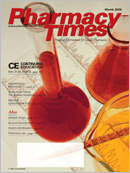Publication
Article
Pharmacy Times
Nosocomial Infections: Impact on Patient Care
Author(s):
Nosocomial infections?also referred to as hospital-acquired infections or health care-associated infections?are defined as infections that are not present or incubating in a patient at the time of admission to a hospital or health care facility. The Centers for Disease Control and Prevention (CDC) estimates that nosocomial infections occur in ~5% to 10% of patients, or >2 million individuals annually. These types of infections also contribute to an estimated 90,000 deaths and cost the US health care system an estimated $4.5 billion to $5.7 billion per year.1,2
Nosocomial infections continue to be a major concern for the health care industry. Hospitals are now required to institute committees responsible for infection control in order to establish guidelines for reducing the incidence of nosocomial infections.2 The CDC estimates that ~36% of nosocomial infections can be prevented if health care workers adhere to specific infection control guidelines when caring for patients.3 In 1985, the CDC's study on the Efficacy of Nosocomial Infection Control reported that hospitals reduced infection control rates by approximately one third when the following 4 key infection control components were implemented4:
- An effective hospital epidemiologist
- An infection control practitioner for every 250 beds
- An active surveillance mechanism
- Ongoing control efforts
Causes
Nosocomial infections can be bacterial, viral, fungal, and even parasitic in nature. The transmission of nosocomial infections typically falls into 5 categories: contact (direct or indirect), droplet, airborne, common vehicle, and vector-borne.5
Various pathogens can contribute to the occurrence of nosocomial infections. The 4 groups of bacteria most commonly responsible for bacterial nosocomial infections are Enterococcus spp, Escherichia coli, Pseudomonas spp, and Staphylococcus spp.2 Nosocomial fungal infections occur in ~9% of nosocomial infections.6
Types of Nosocomial Infections
?Urinary-tract infections, the most prevalent type of nosocomial infection, account for ~35% of all nosocomial infections. Studies have demonstrated that these infections occur after urinary catheterization.
?Surgical-incision-site infections account for 20% of nosocomial infections
?Pneumonia (ventilator-associated) is a prevalent type of nosocomial infection. The most susceptible individuals are those with chronic obstructive pulmonary disease and those utilizing mechanical ventilation. Pneumonia accounts for 15% of nosocomial infections.
?Bloodstream infections account for another 15% of nosocomial infections7
Studies show that ~70% of bacteria that cause nosocomial infections are resistant to at least one antibiotic commonly used to treat them.8 The increased incidence of resistance is a common concern in health care. According to the CDC's National Nosocomial Infection Surveillance System (NNIS System), multidrug- resistant pathogens have become increasingly problematic in recent years, especially in the critical care setting.2
Antibiotic resistance presents challenges in the management and treatment of nosocomial infections. Pathogens such as methicillin-resistant Staphylococcus aureus, vancomycin-resistant S aureus, and vancomycin-resistant enterococci are a major concern.3 The widespread use of antimicrobials for prophylaxis or therapy is considered to be a major factor in antibiotic resistance.9
Who Is at Greater Risk?
Whereas all hospital patients can be at risk for developing nosocomial infections, pediatric and geriatric patients, as well as patients with compromised immune systems, are at a higher risk (Table). The NNIS System database collected by the CDC demonstrates that the overall infection rate in the pediatric population treated in intensive care units is ~6.1%. The primary types of infections are venous catheter infections and ventilator- associated pneumonia.3
Routine invasive medical procedures can put a patient at risk for developing a nosocomial infection. Examples of such procedures include urinary catheterization, surgical procedures and/or wound dressing of surgical sites, utilization of nasogastric or endotracheal tubes, respiratory procedures such as mechanical ventilation or intubations, intravenous procedures for delivery of medications, and parenteral nutrition. The results of a study, published in Infection Control and Hospital Epidemiology, show that ~24% of patients who have catheters will develop catheter-related infections, and 5.2% of these patients will contract bloodstream infections.3
Conclusions
Nosocomial infections can affect the quality of patient care and increase health care treatment costs. Health care institutions can prevent or reduce the incidence of many nosocomial infections by effectively incorporating an infection control program and following the recommendations of the CDC.
Pharmacists play a fundamental role in infection control by incorporating strict infection strategies in medication preparation and dispensing and by ensuring that proper aseptic technique is used.As clinicians, pharmacists can evaluate patient medication profiles, make recommendations concerning the appropriate usage of antibiotics, decrease unnecessary antibiotic usage, and focus on interventions that may enhance infection control.
In an effort to improve the quality of health care for patients, it is imperative for health care workers to understand clearly how infections can be transmitted, to focus on means of implementing preventive measures, and potentially to reduce these types of infections.
Ms. Terrie is a clinical pharmacy writer based in the northern Virginia area.
For a list of references, send a stamped, self-addressed envelope to: References Department, Attn. A. Stahl, Pharmacy Times, 241 Forsgate Drive, Jamesburg, NJ 08831; or send an e-mail request to: [email protected].







